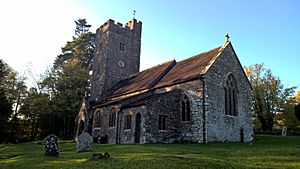All Saints' Church, Huntsham facts for kids
Quick facts for kids All Saints' Church, Huntsham |
|
|---|---|

All Saints' Church, Huntsham
|
|
| 50°58′30″N 3°25′26″W / 50.97500°N 3.42389°W | |
| OS grid reference | ST 00137 20461 |
| Location | Huntsham, Devon |
| Country | England |
| Denomination | Church of England |
| Website | hukeleymissioncommunity.org |
| History | |
| Founded | Tower circa 14th Century |
| Consecrated | 15 June 1336 |
| Architecture | |
| Architect(s) | Benjamin Ferrey (rebuild 1854–56) |
| Specifications | |
| Height | 60 feet (18 m) |
| Bells | 8 |
| Administration | |
| Parish | Huntsham |
| Deanery | Tiverton and Cullompton |
| Archdeaconry | Exeter |
| Diocese | Diocese of Exeter |
All Saints' Church, Huntsham is a beautiful old church in the small village of Huntsham, England. It's about 5.8 miles north-east of Tiverton. This church is part of the Church of England and is considered a special historic building, known as a Grade II* listed building. It belongs to a group of churches called the Hukeley Mission, which also includes churches in nearby villages like Bampton and Clayhanger.
Contents
The Church's Story: A Look Back in Time
Records show that Huntsham Church was officially opened on June 15, 1336. It was made bigger in 1430. The first known leader of the church, called a rector, was Roger de Respremme in 1263. Church records from 1558 tell us that in 1666, the people of Huntsham sent money to help those affected by the Great Fire of London.
A Time of Neglect and Renewal
By 1850, the church was in very poor condition. It was covered in ivy and falling apart because it had been neglected for many years. The owner of the estate, Rev. Edward Berkeley Troyte, lived next door. He was known for not taking good care of the church.
However, things changed in 1852 when Arthur Troyte took over. He quickly decided to fix up the church. Between 1854 and 1856, he hired an architect named Benjamin Ferrey to completely rebuild it. Today, only the lower part of the church tower is from the original 14th century building.
Arthur Troyte was very involved in the rebuilding. He made sure only the best materials were used, like strong oak wood, Ham Hill stone, and colorful floor tiles. He also added beautiful stained glass windows made by Wailes. The churchyard was made larger, and a special gate called a lychgate was built. Arthur Troyte even paid for the work himself by selling 1,000 oak trees to the Royal Navy.
Remembering Arthur and Fanny Troyte
Arthur Troyte's wife, Fanny, passed away just two months before the church restoration was finished in November 1856. To remember her, the church members gave a beautifully decorated stone font. When Arthur died in 1857, a large hanging light fixture, called a candelabrum, was given in his memory. Their graves in the churchyard are marked by special iron crosses.
More Improvements and Bell Ringing
Arthur Troyte's son, Charles Troyte, continued to improve the church. In 1871, a new section called the north aisle was added. More bells were also put in. In 1866, three new bells were added, making a total of six. Then, in 1874, two more bells were added, bringing the total to eight. This allowed for a special type of bell ringing called a "full peal."
On February 2, 1875, the first full peal of 5,040 "Grandsire Triples" was rung by John Acland Troyte. A plaque inside the church celebrates this amazing achievement. In 1872, Charles Troyte wrote a book called Change Ringing, which became a very important guide for bell ringers. This book even inspired the famous writer Dorothy L. Sayers to write her mystery novel, The Nine Tailors.
The tradition of bell ringing is still very strong at Huntsham today. The church's tower is used for practice by The Troyte Ringing Centre.
Church Organ
The church has an organ made by Hele & Co in 1896. The pipes of the organ are decorated with paintings in memory of Charles Troyte, who passed away that year.
Church Clock
The clock on the east wall of the tower was installed in 1912 by a famous company called Messrs Smith and Son of Derby. It cost £34, which was raised by donations. The clock strikes every hour. It used to need winding every week, but now it runs on electricity.
Images for kids



